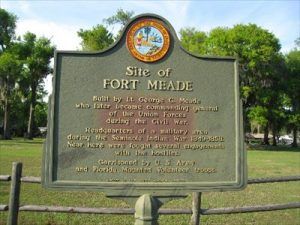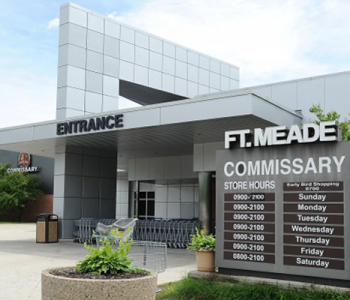
Fort Meade, Florida: Echoes of a Forgotten Frontier
In the annals of American military history, few names carry as much weight and widespread recognition as "Fort Meade." For many, the name immediately conjures images of clandestine intelligence operations, the National Security Agency (NSA), and the cutting-edge cyber warfare command in Maryland. Yet, far from the digital battlefields of the Mid-Atlantic, in the sun-drenched heart of Florida, lies another, largely forgotten Fort Meade – a name that speaks not of satellites and supercomputers, but of log palisades, musket fire, and the brutal realities of America’s frontier expansion.
This article delves into the intriguing, often overlooked history of Fort Meade, Florida, a military post that played a pivotal, albeit humble, role in the Seminole Wars, shaping the landscape and destiny of a nascent state. It is a tale of conflict, endurance, and the enduring legacy of a name that, through the currents of time, has come to mean something entirely different in another corner of the nation.
The Crucible of Conflict: Frontier Florida in the 19th Century

To understand Fort Meade, Florida, one must first grasp the tumultuous environment of Florida in the mid-19th century. Far from the tourist haven it is today, Florida was a vast, untamed wilderness, a mosaic of dense swamps, pine forests, and fertile plains, largely inhabited by the tenacious Seminole people. Following its acquisition from Spain in 1821, American settlers began to push into the territory, eager for land and resources. This westward expansion inevitably clashed with the indigenous populations, leading to a series of protracted and bloody conflicts known as the Seminole Wars.
The Second Seminole War (1835-1842), often described as America’s longest and costliest Indian war, was particularly brutal. It pitted the might of the U.S. Army against a determined and elusive foe, skilled in guerrilla warfare and intimately familiar with the unforgiving terrain. As the conflict dragged on, the military found itself in desperate need of a network of forts and outposts to secure supply lines, protect settlers, and serve as staging grounds for operations deep within Seminole territory. It was into this crucible that the first iterations of Fort Meade, Florida, would emerge.
The Birth of a Frontier Outpost
While the name "Fort Meade" might evoke a single, permanent structure, the reality of frontier forts was often more fluid. They were frequently temporary, hastily constructed stockades, often abandoned and rebuilt as the front lines shifted. The specific Fort Meade that gives its name to the modern Florida town was formally established in 1849, during the period following the Second Seminole War but preceding the Third Seminole War (1855-1858). Its primary purpose was to maintain a military presence, protect the burgeoning settler population, and manage the ongoing, albeit diminished, threat from remaining Seminole bands.
Located strategically on the Peace River, a vital waterway that snaked through central Florida, the fort was established by Brevet Colonel David E. Twiggs of the U.S. Army. The choice of location was deliberate: the river provided a crucial artery for transportation and supply in a region with few roads. The fort served as a supply depot and a base for patrols, aiming to prevent further conflict and enforce the relocation policies that sought to remove the Seminoles from Florida.
Life at Fort Meade was anything but glamorous. Soldiers, often young and inexperienced, faced a harsh existence. The Florida climate – sweltering heat, torrential rains, and relentless humidity – was a constant adversary. Mosquitoes, carrying diseases like malaria and yellow fever, were a more insidious threat than any Seminole warrior. Supplies were often meager, and isolation was profound. Letters home from soldiers stationed in Florida frequently painted a bleak picture of their conditions. One soldier, writing from a similar frontier post, lamented, "We are constantly on the alert, yet disease takes more of us than the enemy. The swamp is our true foe."
The Seminole Wars and Fort Meade’s Role
While Fort Meade was not the site of major, decisive battles, its existence was crucial to the overall U.S. strategy during the Seminole Wars. These small forts, often little more than a palisade and a few log buildings, acted as anchors in the vast wilderness. They provided a sense of security for settlers pushing into the interior, allowing for the establishment of farms and nascent communities. They also served as critical intelligence hubs, with scouts and patrols venturing out to track Seminole movements and gather information.

The Seminole people, led by figures like Osceola and Billy Bowlegs, fought fiercely to retain their ancestral lands. Their resistance was a testament to their resilience and deep connection to the Florida landscape. For the soldiers at Fort Meade, the conflict was less about grand strategy and more about daily vigilance, the constant threat of ambush, and the psychological toll of fighting an enemy who knew the land intimately and often struck without warning. The fort represented the encroaching American presence, a symbol of the relentless pressure on the Seminole way of life.
An interesting fact about the Seminole Wars is their sheer duration and cost. Estimates vary, but the Second Seminole War alone cost the U.S. government upwards of $20 million (a staggering sum at the time) and claimed the lives of over 1,500 American soldiers, many more to disease than combat. This makes the small, seemingly insignificant outposts like Fort Meade all the more vital in understanding the logistical and human cost of the conflict.
From Military Post to Civilian Town
As the Seminole Wars gradually wound down – not with a decisive surrender, but with the slow, painful attrition of the Seminole population and their forced removal – the need for many of Florida’s frontier forts diminished. By the late 1850s, the military presence at Fort Meade was significantly reduced, and by the outbreak of the Civil War, it was largely abandoned as a formal military installation.
However, the name and the infrastructure remained. The location, chosen for its strategic military value, proved equally suitable for civilian settlement. The cleared land, access to the Peace River, and the existing framework of a small community provided a natural foundation for a town. Settlers, who had previously sought refuge or traded at the fort, now saw an opportunity to build a permanent community. The military post transitioned into a civilian settlement, retaining the name that had marked its origins: Fort Meade, Florida.
The town grew slowly, developing an economy based on agriculture, particularly citrus, a crop that would become synonymous with Florida. The Peace River continued to be an important economic artery, transporting goods and people. The legacy of the military fort became ingrained in the very identity of the town, a constant reminder of its frontier past.
The Enduring Legacy: A Name and a Story
Today, the town of Fort Meade, Florida, with a population of just over 6,000, stands as the most tangible legacy of the military post. There are no imposing stone walls or grand parade grounds remaining. The original fort structures, built of wood, long ago succumbed to time, weather, and development. What exists are historical markers, local museums, and the collective memory of a community proud of its unique heritage.
One might find a historical marker near the Peace River, perhaps detailing the fort’s establishment or a significant event. The Fort Meade Historical Society works diligently to preserve the stories, artifacts, and photographs that connect the present-day town to its military roots. These efforts are crucial, as they ensure that the complex, often challenging, history of Florida’s frontier is not forgotten.
The story of Fort Meade, Florida, serves as a powerful reminder that history is layered and often contains surprising juxtapositions. It is a testament to the fact that even seemingly minor outposts played critical roles in larger conflicts, shaping not just battlefields but also the very fabric of American settlement.
Moreover, it underscores the importance of distinguishing between historical entities that share a name. While the Fort Meade in Maryland has garnered global recognition for its modern strategic importance, the Fort Meade in Florida holds a different, equally vital place in the nation’s narrative. It represents a raw, formative period of American history – a time of expansion, conflict, and the forging of new communities in a challenging wilderness.
Conclusion: More Than Just a Name
Fort Meade, Florida, is more than just a historical footnote or a source of geographical confusion. It is a vibrant, living connection to a pivotal era in American history. It tells a story of the fierce struggle for control of the Florida peninsula, the hardships faced by both soldiers and settlers, and the tragic displacement of the Seminole people.
While the sounds of musket fire and the cries of frontier conflict have long faded, the echoes of that era persist in the name of the town and in the historical consciousness of its residents. It stands as a silent sentinel to a past that, though less publicized than its Maryland namesake, is no less significant in understanding the intricate, often challenging, journey of the United States. In a world increasingly dominated by the digital and the immediate, the story of Fort Meade, Florida, invites us to pause, look beyond the headlines, and appreciate the rich, complex tapestry of history that lies beneath our feet, waiting to be rediscovered.


